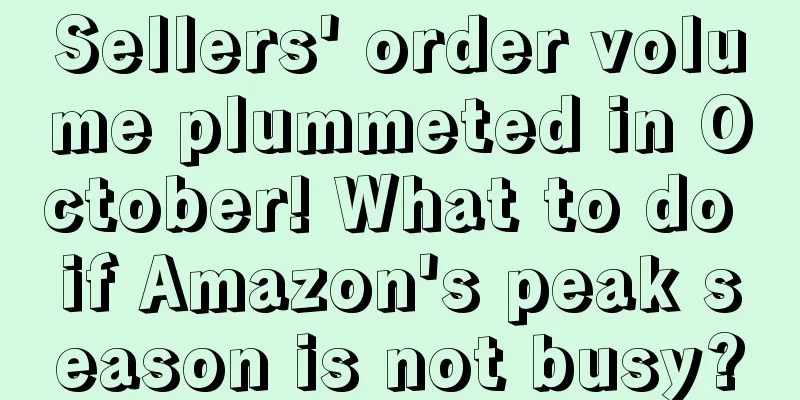Sellers' order volume plummeted in October! What to do if Amazon's peak season is not busy?

|
At this time of year, Amazon’s “slack season” phenomenon always makes sellers anxious. The situation this year is even more serious! In the just-concluded Prime Fall Sale, many sellers failed to make it, and after the sale, sales plummeted, leaving many sellers feeling under great pressure. Sales volume collapsed in October, are sellers losing their minds? Most sellers not only failed to welcome the expected peak season, but also fell into the dilemma of halving orders and declining rankings: Some sellers reported that the sales of their previously hot-selling products plummeted after the autumn promotion, and even after adjusting prices and increasing discounts, it was still difficult to prevent the sales decline. Some stores have seen a sharp decline in sales since October 10, even to less than half of their usual sales, with no signs of recovery at all. After the big sale, there was not a single order from the flash sale and the ranking did not fluctuate at all. A month’s worth of merchandise was sold in just two days during the membership day, but orders dropped even more sharply after the event ended. Not only sales volume, but also platform traffic was disappointing. The traffic surge in October that many sellers had expected did not come. Instead, rankings and sales volume continued to decline. Faced with such a "critical hit", some sellers said that this was due to the redistribution of traffic on the Amazon platform, and the performance of the original core Top links was not as good as before. Other sellers suggested that the weakness after the big promotion may be only a temporary phenomenon, and it might be a good idea to observe for a week or two before taking action.
This year, Amazon’s Black Friday Cyber Monday event was extended from a few days to 12 days, setting a record high and bringing greater opportunities to sellers. It is predicted that during this year's Black Friday and Cyber Monday, US retail sales will increase by 5% year-on-year to US$75 billion, which may set a new record. Many sellers are confident that the upcoming big promotion will be able to reverse the downward trend: "The order volume of the previous big promotions was better than last year, and the performance of Black Friday and Cyber Monday should not be bad either. Some sellers also said they have entered battle preparation mode, adjusting their inventory, advertising and operational strategies in order to make a comeback at the end of the year. Self-help guide: ideas for adjusting operations during peak season① Maintain the ranking and weight of core links: In the short term, there is no need to worry about the number of orders. Just maintain a stable ranking and sales volume to avoid losing the competitiveness of core links in the competition for traffic during the peak season. ② Clear inventory at low prices: Screen low-moving ASINs (such as links outside the top 30,000 that still have no sales even after discounts), and use the traffic bonus of Black Friday and Cyber Monday to clear inventory at low prices, prevent inventory costs from rising, and reduce the risk of unsalable products in the later stage. ③ Optimize advertising strategy: Increase advertising budget for the main ASIN and optimize keywords during Black Friday and Cyber Monday to increase exposure while maintaining stable ACOS to ensure maximum promotion effect. ④ Manage inventory properly: Avoid missing out on peak season orders due to insufficient inventory, or increasing storage costs due to excess inventory. Stock up on hot-selling products, but control the quantity of slow-selling products to avoid unnecessary costs. Black Friday and Cyber Monday at the end of the year will be the last explosive order node in 2024. By mastering the operation rhythm and inventory planning and improving advertising effectiveness, sellers may still have the opportunity to seize the initiative in this wave of traffic dividends and usher in a counterattack in sales. |
<<: Amazon’s new product advertising strategy, a complete analysis of weekly advertising details!
Recommend
What is HipVan? HipVan Review
HipVan is a website that sells mainly designs, inc...
What is TinyDeal? TinyDeal Review
Shenzhen Digital Times Technology Co., Ltd. (TinyD...
What is soulaca? Soulaca Review
soulaca is a business unit of Shineworld Innovatio...
Semi-hosting is becoming popular, interpretation of the cross-border e-commerce market in the first half of 2024!
▲ Scan the QR code and reply “ 2024H1 ” to get the...
How serious is Meta's financial crisis? Layoffs, cancellation of technology projects, and cuts in department spending!
It is learned that Mark Zuckerberg's company M...
What is MUAA? MUAA Review
Multi-User Account Access (MUAA) is a new feature ...
What is AMZKE Sunke Alliance? AMZKE Sunke Alliance Review
AMZKE is a cross-border e-commerce Amazon off-site...
Mason's container volume breaks 60,000! Freight forwarders make a lot of money, but sellers lose 1 million in a year?
Under the impact of the epidemic in 2020, cross-bo...
Health Canada urgently recalls multiple products! Involving Amazon, Costco and other platforms!
<span data-docs-delta="[[20,"获悉,据外媒报道,近日加拿...
What is Costco? Costco Review
Costco (full name Costco Wholesale Corporation) wa...
What is Westwing? Westwing Review
Westwing was founded in 2011 by Delia Lachance (né...
Responding to Verna: Patriots are never alone
First of all, I want to make it clear that no mat...
What is Qaya? Qaya Review
Qaya is part of Area120, an incubator for new prod...
What is VNLIN Middle East e-commerce logistics? VNLIN Middle East e-commerce logistics review
Vnlin Middle East E - commerce Logistics is a lead...
Is this really a spiral of low prices? Have you ever thought that at this price, others still have a 30% gross profit! !
Is it really involution? Have you ever thought ab...









